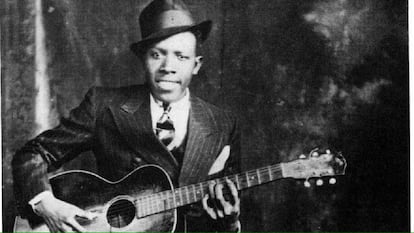‘Sinners’: Tracing in the devil blues behind the hit movie
The film, a surprise box office success due to its horror-musical mix, spins a gruesome plot connected to the symbolism of the noir musical genre

The only thing that subdued the indestructible Howlin’ Wolf during his eventful life was the rejection he experienced from his mother. Wolf, the epicenter of blues music and a 6′1″ (1.98 m) tall, 300-pound (135-kilo) powerhouse, was kicked out of his home when he was 10 years old.
He was already beginning to take a liking to the blues, and Gertrude, his mother, a religious fanatic who sang in the church choir, couldn’t stand her son getting lost in that rhythm, played in nightclubs. Already a blues figure and beacon for rock stars (Keith Richards, Led Zeppelin, Tom Waits, and Eric Clapton are fans, to name just a few), Wolf tried to contact his mother, even offering the money he had at the time as a lure. But Gertrude slammed the door in his face. “You sing the devil’s music,” she argued, refusing to see him. Wolf, who died in 1976 at the age of 65, took to the grave the heartbreak of this maternal rejection.
Sinners, the cinematic blockbuster of the moment opens with a variation on this episode from Howlin’ Wolf’s life: a bewildered and bloodied Sammie bursts into church as his preacher father labors on with his Sunday sermon; the boy, who seems to have spent the night fighting Satan, has only one thing to hold on to: the splintered neck of a guitar, which he grips tightly as if it were his only means of salvation.
“If you keep dancing with the devil, one day he’ll come chasing you home,” the father warns his son, a musician just starting out in his career. It’s the same story that separated Howlin’ Wolf from his mother: the confrontation between the profane (the blues) and the sacred (the church).

Sinners is directed by Ryan Coogler, who is responsible for the two Black Panther films and Rocky spin-off Creed, a filmmaker who is a skillful composer of action plots that, strictly speaking, describe the voracity of white people when it comes to appropriating Black cultural identity. Sinners also addresses the human dilemma of the confusing realms occupied by good and evil, and whether they are not one and the same thing.
Few anticipated the success of Sinners, perhaps due to the weak commercial potential of the blues and the movie’s unique combination of genres: musical, action, horror, period, and vampires. In the U.S. it has already grossed $187 million as of May 6, compared to $79 million for the latest Marvel offering, Thunderbolts* (the latter was released two weeks later). The difference also lies in the budgets of each: Sinners cost $90 million and the Marvel film $180 million.
The blues are fertile ground for legend to germinate and eventually take shape. Sinners is set in the 1930s, in a country — the United States — still reeling from the 1929 crash and with unbearable levels of racism. In that context, the Mississippi Delta blues developed, a rural, authentic blues that later became electrified in metropolises like Chicago. Musicians would leave for months at a time to make a living, lending their guitars and voices for food and drink. Some returned, others didn’t. The cleverest of those who survived invented stories shrouded in mystery and interventions from beyond the grave, gruesome tales that ended up being taken as true: how could a legend that has endured for almost a century not be credible?
Sinners throws the musical symbolism of the era into the narrative. At the center of all of them is that of Robert Johnson (1911–1938), perhaps the most influential blues musician in history. Therein lies his famous pact with the devil, who kept his soul in exchange for giving him extraordinary musical talent. This interweaving of mystery, religion, sex, and violence is what the film’s director artfully works. Johnson, who died at 27, left behind only 29 songs. One is titled Me and the Devil Blues, in which he sings: “Early this mornin’ / When you knocked upon my door / And I said, Hello, Satan / I believe it’s time to go.”
Sammie’s guitar is given to him by twins Smoke and Stack (played by the same actor, Michael B. Jordan) “after winning it at cards from Charley Patton.” The boy receiving the instrument is amazed, because Patton (1891–1934) is another of the titans of the blues: he was more popular than Johnson during both of their lifetimes, but he was subsequently forgotten.
In addition to being an excellent bluesman, Patton was a real force to be reckoned with: he would drink from morning and by early afternoon he would already have gotten into fights. At night, he played in dives with his raspy voice and his guitar riffs, which stars like Johnny Winter and Jack White have admitted to copying. Bob Dylan paid tribute to him in High Water (For Charley Patton).

Perhaps the best supporting actor in Sinners is Delroy Lindo as Delta Slim, a drunken harmonica player who will be crucial in the final battle with the vampires. His character is very reminiscent of Little Walter (1930-1968), the best harmonica player of the golden age of the blues. Walter recorded with Muddy Waters and solo, but he squandered his talent on barrels of alcohol that led to an aggressive temper. He deservedly earned the nickname “The Bad Boy of the Blues.” But how well he played the harmonica.
The traces of the blues are perceptible in Sinners even when the music isn’t playing. For example: one character asks another, “How are you?” and the response is, “No point in complaining.” Better to dance and sing. A good part of the film’s two hours and 17 minutes take place in a lumberyard converted into a nightclub. It’s the smoky space where lascivious glances cross, the place where the blues comes into its own, with its tribal feel, its syncopated rhythms, and its growls.
Later, white musicians (the Beatles, the Who, the Rolling Stones) transformed it into a fan phenomenon with performances before thousands of teenagers. There was generosity on the part of some budding new pop stars, who welcomed their Black idols as opening acts. When the Stones visited their beloved Chess studios in Chicago in the 1960s, they were astounded to see their hero, Muddy Waters, painting the ceiling with a broad brush, his face covered in whitewash. An image that could define Sinners: whites appropriating Black values.

Longed-for freedom hovers throughout the film, a freedom questioned by a racist society with whites at the wheel. This space of freedom is represented by the dive bar, the only place where Black people of the time felt they could behave as they pleased. In the final stretch, Buddy Guy, 88, the last great living electric blues artist, appears. Guy plays the adult version of Sammie, the preacher’s son. (Warning: spoilers ahead).
Sammie has made a career as a musician and is enjoying his last few active years playing in clubs. There, sitting in a bar, he is presented with his own pact with the devil, but this time it’s a vampire: one bite and you’ll achieve immortality. It’ll be gentle, I promise. But, unlike Robert Johnson, Buddy Guy’s character doesn’t sign the agreement. “We’ve lived long enough,” he says. And the vampires respect the blues master.
Sign up for our weekly newsletter to get more English-language news coverage from EL PAÍS USA Edition
Tu suscripción se está usando en otro dispositivo
¿Quieres añadir otro usuario a tu suscripción?
Si continúas leyendo en este dispositivo, no se podrá leer en el otro.
FlechaTu suscripción se está usando en otro dispositivo y solo puedes acceder a EL PAÍS desde un dispositivo a la vez.
Si quieres compartir tu cuenta, cambia tu suscripción a la modalidad Premium, así podrás añadir otro usuario. Cada uno accederá con su propia cuenta de email, lo que os permitirá personalizar vuestra experiencia en EL PAÍS.
¿Tienes una suscripción de empresa? Accede aquí para contratar más cuentas.
En el caso de no saber quién está usando tu cuenta, te recomendamos cambiar tu contraseña aquí.
Si decides continuar compartiendo tu cuenta, este mensaje se mostrará en tu dispositivo y en el de la otra persona que está usando tu cuenta de forma indefinida, afectando a tu experiencia de lectura. Puedes consultar aquí los términos y condiciones de la suscripción digital.
More information
Archived In
Últimas noticias
The story of the Málaga virus: The code that haunted Google’s cybersecurity center director for 30 years
The impact of Ecuador’s mega-prison: A polluted river, cleared forests and military checkpoints
Corinne Low: ‘I’m more concerned about the female happiness gap than the gender wage gap’
Trump traveled on Epstein’s plane ‘many more times’ than previously thought, according to new documents
Most viewed
- The low-cost creative revolution: How technology is making art accessible to everyone
- Christian Louboutin: ‘Young people don’t want to be like their parents. And if their parents wear sneakers, they’re going to look for something else’
- All the effects of gentrification in one corner of Mexico’s Colonia Roma
- Liset Menéndez de la Prida, neuroscientist: ‘It’s not normal to constantly seek pleasure; it’s important to be bored, to be calm’
- Christmas loses its festive spirit: ICE fears cast shadow over religious celebrations











































